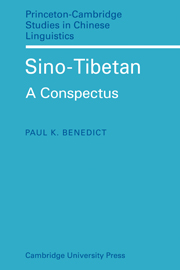Book contents
- Frontmatter
- Foreword
- Contents
- Preface
- Abbreviations
- 1 Introduction
- 2 Taxonomy (general)
- 3 Taxonomy (Sino-Tibetan)
- 4 Tibeto-Burman classification
- 5 Tibeto-Burman reconstruction (history)
- 6 Tibeto-Burman primary sources
- 7 Tibeto-Burman consonants (general; final)
- 8 Tibeto-Burman consonants (initial)
- 9 Tibeto-Burman consonant clusters
- 10 Tibeto-Burman vowels (finals; diphthongs)
- 11 Tibeto-Burman vowels (medials)
- 12 Tibeto-Burman tones
- 13 Tibeto-Burman morphology (history)
- 14 Tibeto-Burman morphology (categories)
- 15 Tibeto-Burman pronouns
- 16 Tibeto-Burman numerals
- 17 Tibeto-Burman morphology and syntax (general)
- 18 Tibeto-Burman affixes (special)
- 19 Tibeto-Burman affixes (general)
- 20 Tibeto-Burman dental suffixes
- 21 Tibeto-Burman prefixes (general)
- 22 Tibeto-Burman prefixed *s-
- 23 Tibeto-Burman prefixed *r-
- 24 Tibeto-Burman prefixed *b-
- 25 Tibeto-Burman prefixed *g-
- 26 Tibeto-Burman prefixed *d-
- 27 Tibeto-Burman prefixed *m-
- 28 Tibeto-Burman prefixed *a-
- 29 Tibeto-Burman alternation (consonantal, vocalic)
- 30 Karen (general)
- 31 Karen morphology (categories) and syntax
- 32 Karen pronouns
- 33 Karen numerals
- 34 Karen prefixes
- 35 Karen initial consonants and clusters
- 36 Karen final consonants and medial vowels
- 37 Karen final vowels and semi-vowels
- 38 Karen tones
- 39 Chinese (general, history)
- 40 Chinese morphology (prefixes, suffixes, alternation)
- 41 Chinese pronouns
- 42 Chinese numerals
- 43 Chinese phonology (history)
- 44 Chinese consonants (initials, finals)
- 45 Chinese consonant clusters
- 46 Chinese vowels and diphthongs
- 47 Chinese tones
- 48 Résumé (Chinese)
- Appendix I Tibeto-Burman roots
- Appendix II English–TB index
- Appendix III Primary Tibeto-Burman sources
- Appendix IV Author's and editor's bibliography
28 - Tibeto-Burman prefixed *a-
Published online by Cambridge University Press: 10 November 2010
- Frontmatter
- Foreword
- Contents
- Preface
- Abbreviations
- 1 Introduction
- 2 Taxonomy (general)
- 3 Taxonomy (Sino-Tibetan)
- 4 Tibeto-Burman classification
- 5 Tibeto-Burman reconstruction (history)
- 6 Tibeto-Burman primary sources
- 7 Tibeto-Burman consonants (general; final)
- 8 Tibeto-Burman consonants (initial)
- 9 Tibeto-Burman consonant clusters
- 10 Tibeto-Burman vowels (finals; diphthongs)
- 11 Tibeto-Burman vowels (medials)
- 12 Tibeto-Burman tones
- 13 Tibeto-Burman morphology (history)
- 14 Tibeto-Burman morphology (categories)
- 15 Tibeto-Burman pronouns
- 16 Tibeto-Burman numerals
- 17 Tibeto-Burman morphology and syntax (general)
- 18 Tibeto-Burman affixes (special)
- 19 Tibeto-Burman affixes (general)
- 20 Tibeto-Burman dental suffixes
- 21 Tibeto-Burman prefixes (general)
- 22 Tibeto-Burman prefixed *s-
- 23 Tibeto-Burman prefixed *r-
- 24 Tibeto-Burman prefixed *b-
- 25 Tibeto-Burman prefixed *g-
- 26 Tibeto-Burman prefixed *d-
- 27 Tibeto-Burman prefixed *m-
- 28 Tibeto-Burman prefixed *a-
- 29 Tibeto-Burman alternation (consonantal, vocalic)
- 30 Karen (general)
- 31 Karen morphology (categories) and syntax
- 32 Karen pronouns
- 33 Karen numerals
- 34 Karen prefixes
- 35 Karen initial consonants and clusters
- 36 Karen final consonants and medial vowels
- 37 Karen final vowels and semi-vowels
- 38 Karen tones
- 39 Chinese (general, history)
- 40 Chinese morphology (prefixes, suffixes, alternation)
- 41 Chinese pronouns
- 42 Chinese numerals
- 43 Chinese phonology (history)
- 44 Chinese consonants (initials, finals)
- 45 Chinese consonant clusters
- 46 Chinese vowels and diphthongs
- 47 Chinese tones
- 48 Résumé (Chinese)
- Appendix I Tibeto-Burman roots
- Appendix II English–TB index
- Appendix III Primary Tibeto-Burman sources
- Appendix IV Author's and editor's bibliography
Summary
Prefixed *m- as a pronominal element can profitably be compared with TB *a-, of almost universal distribution in the family. This element occurs as an independent 3rd person pronoun in Kiranti and Kuki-Naga (a-ma, a-ni), and as a pronominal prefix (ǝ-) in these same groups; cf. Aimol rǝmai ‘tail’, rul ǝrmai ‘snake's tail’; Bahing biŋ ǝta-mi ‘calf’ (‘cow its-child’), byar ǝpwaku ‘sugar-cane’ (‘cane its-juice’). Throughout the TB area in general, however, a lapsing of function can be observed, and the prefix is retained only in forms (normally kinship terms or words for parts of the body) used independently, i.e. without the customary pronominal prefixes, e.g. K wa or ǝwa ‘father’ (nwa ‘thy father’, kǝwa ‘his father’), mun∼ǝmun ‘body hair’, myi∼ǝmyi ‘eye’; Nung ǝkhö ‘uncle’, ǝna ‘ear’; B ӑbhá (ӑphá) ‘father’, ӑmí ‘mother’ (but mí-bá ‘parents’), ӑsà ‘flesh’ (but nwà-sà ‘beef’ = ‘cattle-flesh’); G apa ‘father’, ama ‘mother’; Mikir ari∼ri ‘hand’, aso∼so ‘child’; Lhota Naga okhe ‘hand’, eŋu ‘neck’, oka ‘daughter’, eŋü ‘wife’ (*a->o-∼e-), sho ǝho ‘tooth’, ǝtü ‘grandson’. Semantic specialization is sometimes encountered; cf. B swà ‘tooth’, ӑswà ‘cutting edge’; im ‘house’, ӑim ‘sheath’; myak ‘eye’, ӑmyak ‘knot in timber’; Lepcha uŋ ‘water’, ӑuŋ ‘water in which meat has been boiled’; vi ‘blood’, ӑvi ‘menses’; vyeŋ ‘door’, ӑvyeŋ ‘pass’; kuŋ ‘tree’, ӑkuŋ ‘bush’; rip ‘flower’, ӑrip ‘flower of cloth’.
- Type
- Chapter
- Information
- Sino-TibetanA Conspectus, pp. 121 - 123Publisher: Cambridge University PressPrint publication year: 1972



